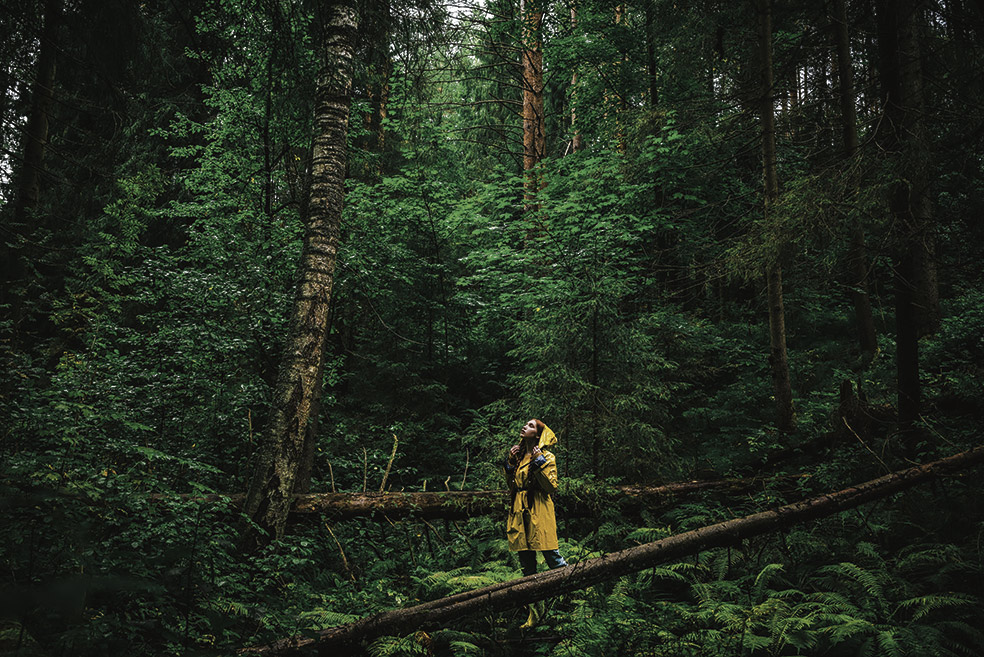ORA meteor shower can leave us speechless. Also a newborn or a Cirque du Soleil show. Neuroscientist Beau Lotto conducted a study during the performances of this Canadian company in Las Vegas. About 300 spectators answered questionnaires, and some wore electrode caps to measure the neuronal response of the subjects. They found that the amazement produced by the artists’ impossible pirouettes leads us to forget our thoughts and live in the present; It predisposes us to the unknown and to ask ourselves questions; acts as a counterweight to stress; and has elements in common with the neurological response to psychedelics. They also recorded greater neural activity, where our creativity develops.
Humility and gratitude
“In amazement there is a component of immensity,” explains José Pizarro, social psychologist and researcher at the University of the Basque Country. “It guides us toward something bigger than ourselves.” Contemplating a landscape of particular beauty, the Taj Majal or the Milky Way on a starry night can provoke this feeling. Also a concert, a religious experience or a political rally. «They are things that make you feel small, they have a lot of humility and gratitude. And they help create a group,” adds Pizarro. It is the opposite of what happens in depression, where there is a lot of rumination: the ego takes the forefront. On the contrary, the humility associated with amazement “allows us to lower our defenses against external ideas,” explains the social psychologist. «We often have a confirmation bias: we look for things that validate our ideas. Something evident today on social networks. Practicing amazement can help stop the current polarization,” concludes this expert.
But what does it mean to practice amazement? There is no need to buy circus tickets or get on a plane to find what amazes us. Amazement can wait around the corner: the so-called ‘wonder walks’ propose precisely that. Taking a walk through a nearby park, observing the surroundings and willing to be surprised by a butterfly, the texture of a log, some unexpectedly shaped stones… This is what research from the Center for Memory and Aging at the University of California at San Francisco. For eight weeks, participants took fifteen-minute walks in nature, at least one a week. In the surveys they filled out, the experience of amazement increased, suggesting that it is an emotion that can be trained. It also reduced negative emotions such as loneliness and others such as compassion or gratitude were revealed. The participants had to take selfies during the walks: at first, they themselves were the protagonists of the photos, but as the weeks progressed they appeared smaller in them, giving more importance to the environment. Furthermore, once the habit of making outings like this was acquired, the frequency with which the subjects felt amazement increased.

Learn to practice wonder
It will only take you fifteen minutes. This is the guide proposed by the University of Berkeley to turn a walk into a unique experience.
Step 1: Before leaving, take a deep breath. Inhale for a count of six and exhale for a count of seven. Feel the air move in your nostrils and listen to the sound of your breathing. Return to this breathing throughout the outing.
Step 2: Feel the ground beneath you and the air on your skin, listen to the surrounding sounds and smell what is around you with a… Read more
“Of course, amazement is more likely to occur in places that have two key characteristics: physical immensity and novelty,” they explain from the Greater Good Science Center at the University of Berkeley. At its head is Dachel Keltner, a psychologist and professor at said university, who has been studying positive emotions such as compassion, love and amazement for more than two decades. His laboratory has collaborated with Google, Pixar and Facebook to find faces that reflect emotions. The result of this collaboration is the emoji that we use today to express amazement: eyes wide open and jaw dropped, as if saying ‘wow’. The expression is practically universal and the emoji is used all over the world today.
“Amazement is more likely to occur in places that have two key characteristics: physical immensity and novelty,” they explain from the University of Berkeley.
«The brain has been designed over millions of years and guides us to look for food or escape from dangerous situations. But he is not used to different things happening at the same time. It focuses on a single sensation –says the magician and trained mathematician Juan Luque–. From the point of view of magic, amazement is marveling at something that we know is impossible. The ‘wow’ effect makes you forget everything, wondering how it could have happened. And, studies agree, amazement makes us concentrate on the present, it seems to dilate time. “The game and wonder never disappear, that’s why magic is more for adults than for children,” concludes the magician. However, a study from the University of Basel in Switzerland published in January of this year concludes that the capacity for wonder does decrease with age. They studied the reaction of young and adult mice to unexpected sounds, with the latter showing less brain activity when surprised.
The benefits of fascination
But what happens to the body when we contemplate something in ecstasy, when we let ourselves be carried away by what experts know as ‘wonderful amazement’? The catalog of physical and neurological effects is extensive. It calms the nervous system, slows the pulse and reduces levels of cortisol, a hormone related to stress, while increasing levels of dopamine, which is associated with relaxation and pleasure. It also acts as a regulator of pro-inflammatory cytokines, small proteins that are essential for our immune system, but which can have negative effects if they are constantly at high levels. In the same way, contemplating a sunset or a stunning rainbow regulates the vagus nerve: a set of nerve fibers that connects the brain with organs such as the heart, lungs, stomach or intestines. Stress, fatigue or anxiety cause inflammation of the vagus nerve. According to researcher Dacher Keltner, positive emotions such as joy, compassion or amazement regulate the tone of the vagus nerve, contributing to our general well-being.
“Amazement is like an engine that leads us to be interested in the environment, to ask questions and look for answers,” explains Javier Sánchez Cañizares, doctor in Physics, theologian and priest, and researcher at the Institute of Culture and Society of the University of Navarra. . He explains that these questions are at the basis of science, philosophy and religion as well. How are they different? «Einstein was amazed by nature, he had an almost religious vision of it. But it did not translate into a personal god, as we are accustomed to in the Christian West. And are we losing our capacity for wonder? “In the most superficial sense yes.” With the proliferation of fake news or manipulations created with artificial intelligence, it seems that nothing surprises us anymore. «But I am optimistic: this can lead us to be amazed by more important things. The human interest us more than the technical answers: falling in love, guilt, forgiveness… That is still present.
